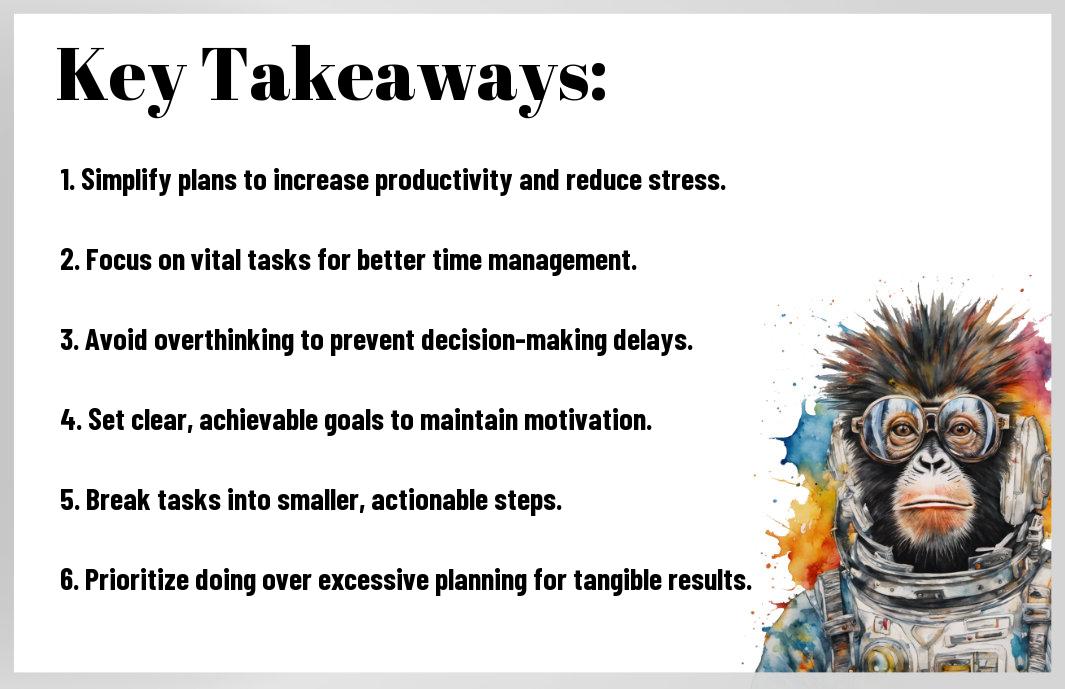Planning effectively is crucial, but you might find yourself caught in a cycle of overplanning that can lead to paralysis and inaction. Every moment spent perfecting your schedule can detract from your ability to actually execute tasks and achieve your goals. Instead, embrace a strategy that prioritizes action over perfection, allowing you to do more with less time spent on logistics. By focusing on what truly matters, you can enhance your productivity and experience a significant boost in your overall effectiveness.
Key Takeaways:
- Embrace flexibility in planning to enhance productivity and creativity, allowing for spontaneous decision-making and action.
- Set achievable goals that focus on results rather than exhaustive plans, prioritizing impactful tasks over extensive preparation.
- Cultivate a habit of reflection and adjustment after completing tasks, helping to streamline future efforts and reduce the tendency to overplan.
Understanding Overplanning
The tendency to overplan can hinder your productivity and overall satisfaction in both personal and professional aspects of life. Overplanning occurs when you become so focused on organizing every detail that you lose sight of the ultimate goal. This habit can lead to a state of inaction, where you spend more time preparing than actually executing your plans, which leaves you feeling overwhelmed and unfulfilled.
Symptoms of Overplanning
Understanding the symptoms of overplanning is vital to recognizing when you might be falling into this trap. Common signs include spending excessive time on research, continually revising plans, or feeling anxious about completing tasks. You might find yourself paralyzed by choices or delaying actions due to fear of making mistakes, which ultimately affects your productivity and well-being.
Causes of Overplanning
On the surface, you may think your desire to plan is constructive, but there are underlying factors that drive overplanning. This behavior often stems from a fear of failure, a desire for perfection, or external pressures. Moreover, the expectation to achieve exceptional results can push you to invest too much time in preparation, rather than taking action.
Considering these factors, it’s important to address the underlying issues contributing to your overplanning tendencies. A strong desire for perfectionism can lead you to set unrealistic standards for yourself, causing you to spend too much time planning instead of executing. Additionally, societal expectations may pressure you to overanalyze every decision, leading to increased anxiety and diminished self-confidence. By recognizing these aspects, you can begin to shift your focus onto making decisions that propel you forward rather than paralyze you with excess planning.

The Dangers of Overplanning Paralysis
You may not realize that overplanning paralysis can limit your ability to act effectively. It can create a mental fog, leading to indecisiveness and a tendency to procrastinate. The more time you spend planning without taking action, the less confidence you may have in your ability to execute tasks, ultimately hindering your productivity and personal growth.
Impact on Productivity
Among the most severe impacts of overplanning paralysis is the decline in productivity. When you devote excessive time to planning, you risk missing out on valuable execution time. This imbalance can lead to a backlog of uncompleted tasks, causing stress that may further inhibit your ability to move forward.
Emotional Consequences
Between anxiety and frustration, the emotional toll of overplanning can be overwhelming. As you struggle to make decisions, you may find yourself feeling stressed and overwhelmed. These emotions can lead to burnout, affecting not only your mental health but also your overall happiness and fulfillment.
Emotional repercussions from overplanning paralysis can spiral quickly. You might find that as your anxiety mounts, decision fatigue sets in, making even simple choices feel daunting. This vicious cycle can lead to feelings of inadequacy and make you doubt your abilities. As frustration builds, your motivation can wane, creating a lingering sense of dissatisfaction with both your work and personal goals. Addressing these emotional challenges is imperative to break free from the shackles of overplanning.
Strategies to Combat Overplanning
For those who find themselves stuck in a cycle of overplanning, adopting effective strategies is necessary. You can start by recognizing that Overplanning and Analysis Paralysis | It’s About Time can hinder your productivity. Embrace the idea that planning is meant to serve your goals, not derail them. Simplify your approach and keep your focus on action.
Setting Clear Priorities
Along with streamlined planning, setting clear priorities is vital for keeping you on track. Identify the most important tasks that align with your goals and tackle them first. This will allow you to allocate your time effectively and reduce feelings of overwhelm.
Implementing Time Management Techniques
Time management techniques can enhance your productivity significantly. You might consider strategies like the Pomodoro Technique or time-blocking to create a structured workflow. These methods can reduce friction in your daily routine and foster a balanced approach to your tasks.
Understanding how to implement effective time management techniques can transform your approach to productivity. By utilizing structures such as time-blocking, you allocate specific periods for tasks, allowing you to focus deeply without excess planning. Techniques like the Pomodoro Technique encourage you to work in short, intense bursts with breaks, enhancing your concentration and maintaining your energy levels. Ultimately, these methods promote a sense of achievement and reduce the risk of falling into the trap of overthinking and analysis paralysis.

The Benefits of Flexible Planning
To thrive in a dynamic environment, flexible planning enables you to respond swiftly to changes and unexpected challenges. This approach allows you to prioritize what really matters, conserving your energy and resources for action rather than getting caught in the details of rigid schedules. With a focus on adaptability, you can seize opportunities as they arise, leading to greater productivity and satisfaction in your work.
Encouraging Adaptability
The key advantage of flexible planning lies in its ability to cultivate adaptability within your workflow. By embracing a fluid approach, you allow yourself to adjust to shifting priorities or circumstances without feeling overwhelmed. This empowers you to navigate challenges more efficiently, ensuring that you remain focused on your goals while adjusting your strategies as needed.
Enhancing Creativity
One notable benefit of flexible planning is its positive impact on your creativity. By relinquishing strict schedules and allowing for spontaneity, you create an environment where innovation can flourish. When you allow yourself room to explore new ideas, you often discover solutions you wouldn’t have considered within a rigid framework. Your ability to pivot and reevaluate enables you to harness fresh insights, leading to a more enriching and rewarding creative process.
Even embracing flexibility in your planning can open doors to unexpected innovations. Allowing for unstructured time encourages your mind to wander, often leading to breakthrough ideas that can enhance your projects. By letting go of the constraints imposed by a stringent plan, you invite exploration and experimentation into your routine. The result is not only enhanced creativity but also a greater sense of fulfillment as you engage fully with your work and unleash your potential.
Tools and Resources to Streamline Planning
Once again, leveraging the right tools can significantly enhance your ability to plan effectively without becoming bogged down. Understanding how to automate repetitive tasks and consolidate multiple planning efforts into cohesive systems will empower you to make decisions more swiftly. Focus on tools that allow for easy collaboration, tracking progress, and adaptation, enabling you to stay agile and responsive to your needs.
Recommended Apps and Software
Across the landscape of planning technology, you can find a variety of apps and software designed to support your workflow. Tools like Trello, Asana, and Notion allow you to manage tasks visually, while Evernote and Microsoft OneNote can help keep your ideas organized. Emphasizing simplicity and functionality in your choices ensures you maintain productivity without falling into the trap of overplanning.
Effective Planning Methodologies
One effective approach is to adopt planning methodologies that promote clarity and action. Agile, kanban, and time blocking are a few popular methods that encourage you to break tasks into manageable pieces. By focusing on what you can accomplish in a specific period, you minimize the tendency to overthink and increase your likelihood of executing projects effectively.
Also, these methodologies offer frameworks to stay on track and help you visualize progress. For instance, the Agile method emphasizes iterative progress, allowing you to adapt as necessary. Kanban focuses on workflow visualization, letting you see where bottlenecks may arise. Time blocking ensures dedicated focus, reducing the chance of distractions affecting your efficiency. By integrating these effective methodologies into your planning process, you’ll find yourself doing more while planning less. This equips you with a roadmap to navigate tasks efficiently and evade the pitfalls of overplanning paralysis.
Real-Life Case Studies
After examining various organizations that have embraced the philosophy of planning less and doing more, several compelling case studies illustrate the value of avoiding overplanning paralysis:
- Company A reduced project timelines by 30% by limiting planning sessions.
- Team B increased productivity by 25% after implementing weekly instead of bi-weekly planning.
- Organization C improved morale significantly, reporting a 40% boost in employee satisfaction after simplifying their planning process.
- Startup D successfully launched 3 new products in 6 months with minimal planning, achieving a 50% market penetration within the first quarter.
Success Stories
Behind these transformations are driven teams that chose to prioritize action over excessive deliberation. One remarkable story involves a tech startup that shifted from a lengthy 6-month planning period to rapid iteration cycles, resulting in faster market entries and user feedback loops. Their approach not only fostered innovation but also attracted investors who valued agility.
Lessons Learned
By observing these case studies, it becomes evident that simplicity in planning leads to better execution. Teams that focus on ineffective planning risk losing momentum and creativity. Making the leap from lengthy prep to swift action can yield faster results and a more engaged workforce.
Further analysis shows that organizations learned key insights, such as the importance of embracing flexibility and the necessity of creating a culture that encourages risk-taking. Teams often found that maintaining an agile approach allowed them to pivot quickly based on real-time feedback, resulting in significant competitive advantages. Dismissing the fear of failure enabled many to experiment, ultimately leading to groundbreaking innovations that propelled their success in the market.
Summing up
So, by adopting the WorkWell approach, you can effectively combat overplanning paralysis, allowing you to focus on what truly matters. Embrace a mindset that prioritizes action over endless scheduling, empowering you to streamline your efforts and enhance productivity. With a clear vision and disciplined execution, you will find greater satisfaction in your achievements. Let WorkWell guide you in balancing your planning and doing, ensuring that your time is spent efficiently and purposefully.
Q: What is “WorkWell – Plan Less, Do More” all about?
A: “WorkWell – Plan Less, Do More” is a productivity framework designed to help individuals and teams overcome the challenges of overplanning and analysis paralysis. The approach emphasizes the importance of action and execution over excessive planning and contemplation. By simplifying the planning process and encouraging spontaneous and effective work habits, users can achieve their goals more efficiently while maintaining flexibility in their tasks and projects.
Q: How can I apply the principles of WorkWell in my daily routine?
A: To incorporate the WorkWell methodology into your daily routine, start by identifying your top priorities for the day or week. Limit the number of tasks you plan to a manageable amount, focusing on what is imperative. Use techniques such as time blocking or the Pomodoro Technique to create dedicated time slots for focused work. Additionally, practice allowing flexibility in your plan—if an opportunity arises or a task takes longer than expected, adjust rather than stress over sticking to a rigid schedule.
Q: What are some common mistakes people make when trying to avoid overplanning?
A: A frequent mistake is the tendency to still create elaborate plans, even when trying to simplify. Instead of prioritizing actionable tasks, individuals may end up creating lists that are overly detailed or exhaustive. Another mistake is neglecting to set time limits for tasks, which can lead to drifting into extensive planning. Lastly, being too rigid with plans, and not being open to spontaneity or change, can undermine the effectiveness of the WorkWell approach. It’s important to strike a balance between having a guideline and being adaptable to unforeseen circumstances.

Leave a Reply